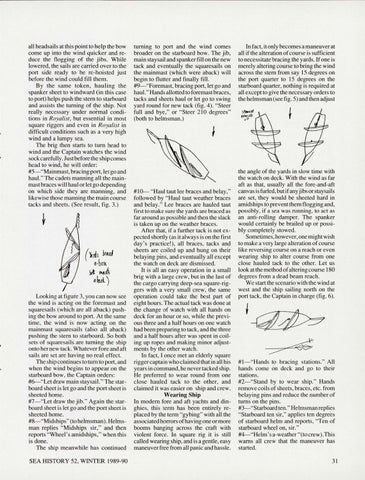all headsails at this point to help the bow come up into the wind quicker and reduce the flogging of the jibs. While lowered, the sails are carried over to the port side ready to be re-hoisted just before the wind could fill them. By the same token, hauling the spanker sheet to windward (in this case to port) helps push tire stem to starboard and assists the turning of the ship. Not really necessary under normal conditions in Royalist, but essential in most square riggers and even in Royalist in difficult conditions such as a very high wind and a lumpy sea. The brig then starts to turn head to wind and the Captain watches the wind sock carefully. Just before the ship comes head to wind, he will order: #5-"Mainmast, bracing port, let go and haul." The cadets manning all the mainmast braces will haul or let go depending on which side they are manning, and likewise those manning the main course tacks and sheets. (See result, fig. 3.)
( ':k~s brtrd
a-box
JJ: ~ it~)
Looking at figure 3, you can now see the wind is acting on the foremast and squaresails (which are all aback) pushing the bow around to port. At the same time, the wind is now acting on the mainmast squaresails (also all aback) pushing the stem to starboard. So both sets of squaresails. are turning the ship onto her new tack. Whatever fore and aft sails are set are having no real effect. The ship continues to tum to port, and when the wind begins to appear on the starboard bow, the Captain orders: #6-"Letdraw main staysail." The starboard sheet is let go and the port sheet is sheeted home. #7-"Let draw the jib." Again the starboard sheet is let go and the port sheet is sheeted home. #8-"Midships" (to helmsman). Helmsman replies "Midships sir," and then reports "Wheel's amidships," when this is done. The ship meanwhile has continued SEA HISTORY 52, WINTER 1989-90
turning to port and the wind comes broader on the starboard bow. The jib, main staysail and spanker fill on the new tack and eventually the squaresails on the mainmast (which were aback) will begin to flutter and finally fill. #9-"Foremast, bracing port, let go and haul." Hands allotted to _foremast braces, tacks and sheets haul or let go to swing yard round for new tack (fig. 4). "Steer full and bye," or "Steer 210 degrees" (both to helmsman.)
#10- "Haul taut lee braces and belay," followed by "Haul taut weather braces and belay." Lee braces are hauled taut first to make sure the yards are braced as far around as possible and then the slack is taken up on the weather braces. After that, if a further tack is not expected shortly (as it always is on the first day's practice!), all braces, tacks and sheets are coiled up and hung on their belaying pins, and eventually all except the watch on deck are dismissed. It is all an easy operation in a small brig with a large crew, but in the last of the cargo carrying deep-sea square-riggers with a very small crew, the same operation could take the best part of eight hours. The actual tack was done at the change of watch with all hands on deck for an hour or so, while the previous three and a half hours on one watch had been preparing to tack, and the three and a half hours after was spent in coiling up ropes and making minor adjustments by the other watch. In fact, I once met an elderly square rigger captain who claimed that in all his years in command, he never tacked ship. He preferred to wear round from one close hauled tack to the other, and claimed it was easier on ship and crew. Wearing Ship In modem fore and aft yachts and dinghies, this term has been entirely replaced by the term "gybing" with all the associated horrors of having one or more booms banging across the craft with violent force. In square rig it is still called wearing ship, and is a gentle, easy maneuver free from all panic and hassle.
In fact, it only becomes a maneuver at all ifthe alteration of course is sufficient to necessitate bracing the yards. If one is merely altering course to bring the wind across the stern from say 15 degrees on the port quarter to 15 degrees on the starboard quarter, nothing is required at all except to give the necessary orders to the helmsman (see fig. 5) and then adjust
the angle of the yards in slow time with the watch on deck. With the wind as far aft as that, usually all the fore-and-aft canvas is furled, but if any jibs or staysails are set, they would be sheeted hard in amidships to prevent them flogging and, possibly, if a sea was nmning, to act as an anti-rolling damper. The spanker would certainly be brailed up or possibly completely stowed. Sometimes, however, one might wish to make a very large alteration of course like reversing course on a reach or even wearing ship to alter course from one close hauled tack to the other. Let us look at the method of altering course 180 degrees from a dead beam reach. We start the scenario with the wind at west and the ship sailing north on the port tack, the Captain in charge (fig. 6).
#1-"Hands to bracing stations." All hands come on deck and go to their stations. #2-"Stand by to wear ship." Hands remove coils of sheets, braces, etc. from belaying pins and reduce the number of turns on the pins. #3-"Starboard ten." Helmsman replies "Starboard ten sir," applies ten degrees of starboard helm and reports, "Ten of starboard wheel on, sir." #4-"Helm'sa-weather "(to crew). This warns all crew that the maneuver has started. 31
